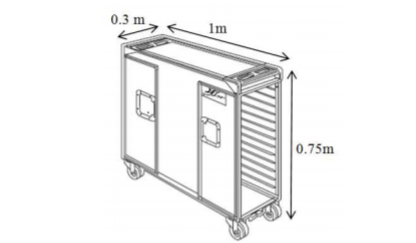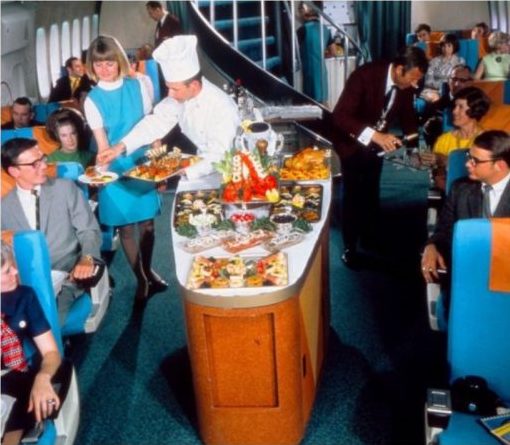Meal
Trolley

Meal trolleys are the most passenger-facing component of the galley. Their design must take into account not only the aisle width but also other galley parts and flight crew coordination.
︎︎︎ Related entries:
In-Flight Food
Meal Tray
︎ Random Entry
Tags: airplane interior, materials,
spatial configuration, proxemics
In-Flight Food
Meal Tray
︎ Random Entry
Tags: airplane interior, materials,
spatial configuration, proxemics
Design Decisions
A meal trolley, also called galley trolley or service trolley, is a wheeled cart used by flight attendants to deliver meals, beverages, or other service items to the seated passengers. It is typically a rigid metal box with castering wheels, doors, and handles, and is stored in the aircraft galleys to be occasionally brought out to the aisles during service time.
 Typical Trolley
Dimensions
Typical Trolley
DimensionsThere are currently only three main design families of service trolleys in use [1, 2]. One reason for this low number of variations is that the trolley is typically designed as part of a kitchen galley set. Service trolleys can be thought of as the most passenger-facing component of the galley, which also includes ovens, fridges, freezers, waste compartments, and other miscellaneous stowage. The intense pressure to maximize space on the aircraft can be easily observed in the puzzle-like combinatorial nature of the galley parts design [3]. The design of the service trolley, therefore, is affected not only by the cabin aisle width, but also by the desire to standardize its form with the other galley stowage compartments
Meal trolleys on the aircraft have a longer history than the typical rigid metal box of today. Before the standardization of galleys, meals were transported to passengers by hand, by portable folding trays, or on large buffet-style tables served by attendants (FIGURES: saved in folder). As the 1960s ushered in a generation of larger widebody airplanes, meals could no longer be efficiently delivered by hand and thus the service trolley system was launched.



Meals served buffet style (1950s, 60s)
As with most cabin interior components, materials used for service trolleys must prioritize abrasion resistance, allowing it to be used and cleaned repeatedly, with high tensile and impact strength even in the dry state and at low temperatures [4]. To account for the effects of turbulence, wheels are equipped with braking pedals, and doors are lockable so that the contents do not spill out.
Effects on Passengers
One psychological effect of the service trolley is that it exacerbates the feeling of being trapped in confined spaces. Its presence nullifies the possibility of leaving the seat for a stretch or usage of the bathroom. This congestion in the aisle frequently causes a line of trapped passengers seeking to return to their seats [2, 5].
The meal trolley should also be considered in the context of its social role as an unintended instigator for interaction. The in-flight meal service provides a rare interruption to the uniformity of the passenger experience between take-off and landing. For many travellers, the brief exchange of words with the flight attendant - coke, please - might be the only social interaction that they have with another person during flight. A less welcome interaction might be the flight attendant awakening a sleeping passenger to ask whether they would like a meal. Moreover, the meal service is one of the only communal experiences that take place on the plane, where all passengers engage in the same activity even if without actively engaging with each other.
Any consideration of the design of the meal tolley must keep in mind that the physical design of the service trolley is inevitably entangled with the systems level design of food delivery and waste collection [6]. This in turn, affects the required number of flight attendants per aircraft, as they are integral to the timing of food delivery and waste collection during flight [2]. Changes to the design of the meal trolley will have repercussions on the number of flight attendants needed per flight, which will most likely have larger implications for the overall passenger experience.
What-Ifs

Design proposal for a meal trolley system on a railing above the aisle [8, 9].
What if there was a way to avoid congestion in the aisles due to trolleys?
Meal trolleys, accompanied by one or two flight attendants, frequently create congestion in the aisles. A line is frequently formed behind the trolleys as passengers seek to go to or return from the lavatory. One design strategy is to use half-width trolleys, where passengers can sidle past [7]. Another design strategy is to transport food on a railing system above the aisle [8. 9]. This solves both the issue of passengers passing by, and also the common complaint among flight attendants that repetitive crouching movements t o retrieve meals cause joint pains.
 Design proposal for half-sized meal trolley to avoid congestion of aisles [7].
Design proposal for half-sized meal trolley to avoid congestion of aisles [7].What if the meal delivery process was automated?
As a temporary measure in light of Covid-19, several carriers are forgoing meal services or providing only pre-packaged snacks. Instead, the traditional meal and trolley service could be replaced by an automat, or a vending machine style of ordering [10]. This would require a rethinking of the kitchen galley entirely. Passengers could select from the menu on an app, and pick up the items from the galley when ready. These in-flight automats could offer more than food, including as amenities items like travel pillows and headphones.
- "SAE AS8056 - Minimum Design and Performance of Airplane Galley In-Flight Carts, Containers, and Associated Components".
-
Romli, F I, K Abdul Rahman, and F D Ishak. 2016. “In-Flight Food Delivery and Waste Collection Service: The Passengers’ Perspective and Potential Improvement.” IOP Conference Series: Materials Science and Engineering 152 (October): 012040.
-
Safran Cabin. n.d. “Galley Division of Safran Cabin.”
- BASF Aerospace. n.d. “Aerospace Materials and Technologies Overview.” BASF Aerospace Materials and Technologies. Accessed June 2, 2020.
- Mei Shin, Koh, Yip Kin Hon, and Salini Devi Rajendran. 2019. “A Study on Passengers Perspective towards In-Flight Food Delivery and Waste Collection Services.” Edited by T.Y. Fang and V. Khaletski. E3S Web of Conferences 136: 04091.
- Avakian, Talia. 2019. “How Airline Food Is Made, According to the Experts.” Travel + Leisure. July 18, 2019.
-
Varma, Gautham. "In-Flight Catering Delight: Re-imagining an Airline Service..." Design Degree Show 2015. May 27, 2015.
-
Seth, Radhika. "The Flying Cart." Yanko Design - Modern Industrial Design News. April 12, 2013.
-
"Cart Line / Airplane Cart." IF WORLD DESIGN GUIDE.
-
Garcia, Marisa. "The Future of Airplane Food Involves Robots, Apps, and Automats." Travel Leisure. April 26, 2019.